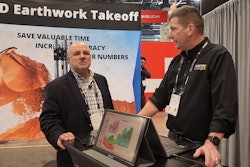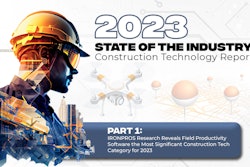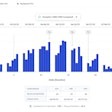
Managing during times of change can be hard. Civil contractors already serve a demanding customer base of government and institutional owners, and now face fluctuating pricing and availability of materials, labor and financing. The rapid advance of business and project technology for civil contractors and project teams could not come at a better time.
Even as contractors and project owners adopt or specify robotic or automated production through 3D paving, equipment guidance and increasingly autonomous construction equipment to reduce cost and risk and improve project quality, the sheer number of variables that go into project planning and execution present a similar opportunity for lean improvements. Unlike automated level control on grading or paving though, planning and project or program management are not about bringing efficiencies to repeatable and predictable processes. A project team benefits from technology that helps them proactively identify and act on opportunities to structure, plan or execute a project. This requires the ability to look forward and identify risks, constraints, potential synchronicities and to arrive at optimal plans. Government owners also may require or certainly appreciate milestone-based project reporting for application for payment—and getting paid is a pretty important dimension all by itself.
Bentley SYNCHRO
In civil construction, much of the data that is consumed in the course of planning will be contained not necessarily in an architectural design file, but in a geographic information system (GIS). Its native support for GIS was already a calling card for SYNCHRO when Bentley bought the company and software product in 2018. This helped Bentley reach beyond design and its stronghold of engineering to establish a firm beachhead in construction operations. More recently, Bentley has extended SYNCHRO’s capabilities for 4D building information modeling (BIM) sequencing, planning and scheduling. SYNCHRO enables configured workflows out of the box with quantities, resources and dollars tied to together to address 5D.
For those who are not BIM nerds, 3D BIM deals with the three spatial dimensions within which BIM can describe a designed or constructed asset. The addition of the time dimension delivers 4D BIM which augments the spatial model with timeline, schedule and duration of activities associated with an infrastructure project. The fifth dimension is money. 5D BIM enables a project team to associate cost with the model for estimating or to balance out cash and resource outflows and payments as a project unfolds dynamically in time. Other dimensions include 6D for sustainability and 7D which extends the model into the management, operation and maintenance portions of the asset lifecycle.
But for civil construction, 4D or 5D provide extensive capabilities not only to design a project based on engineering conventions, but to anticipate how the site, materials and labor availability and multiple other factors. The attribution of cost and value to specific events in SYNCHRO then enables earned value management (EVM) reporting for application for payment.
Attendees of CONEXPO-CON/AGG 2023 Booth #N11865 can get a demonstration of the complete SYNCHRO Construction platform and test-drive SYNCHRO Field on a giant iOS touchscreen. There will also be a full guided demonstration of the complete workflow from Bentley’s civil design software through the SYNCHRO Construction platform, highlighting 4D/5D model-based construction and iTwin technology, as well as all SYNCHRO Control, Cost, Perform, and Field capabilities.
“What we are delivering is 4D sequencing for scheduling validation and to plan execution,” Bentley Systems Vice President of Product Management Richard Humphrey said in a February 2023 IRONPROS debriefing session. “Now we can project labor demand across the project timeline. Our customers can use that to share a vision for how the project will flow with stakeholders. It can also help them identify and fill gaps in the project schedule.”
A project delivery tool is a lot more valuable if it directly extends other solutions used during the project lifecycle. Fortunately, Bentley’s product set for the architecture, engineering and construction (AEC) market is substantial, so SYNCHRO joins an extended family that includes close relatives Bentley Open Roads Designer, the Bentley ProjectWise design delivery system.
Humphrey and Bentley Systems Senior Director, Product Management Corey Johnson also extended the SYNCHRO line by acquisition with the 2021 acquisition of Australian construction field productivity software vendor E7, which would become SYNCHRO Perform, which brings project execution capabilities similar to HCSS HeavyJob. An earlier 2020 acquisition of NoteVault added machine learning enabled voice-driven field capture to deepen and streamline reporting from the field even further.
“The strategy is to build a comprehensive solution for heavy construction, and over five years we have been working on that,” Humphrey said. “We co-opted the brand SYNCHRO because we liked it and it was representative of how we wanted to synch up people, resources, data and workflows in a single environment for infrastructure.”
Since acquiring SYNCHRO, Bentley has gone public so what we have here is a robust civil engineering project modeling and execution tool backed by a billion-dollar enterprise. Not all of Bentley’s 5,000 or so employees work on SYNCHRO. Bentley’s entire sales team and their channel partners can sell SYNCHRO, and smaller accounts can buy through the Virtuosity eStore and get licenses with training and some professional services built in. The product is supported by a dedicated team of about 20 presales engineers and another 20- to 30-person headcount in consulting and customer success.
Customer success and presales will be important because even with a well-designed interface, the digital tools used to support civil construction are changing so fast the three-letter acronyms alone can be hard to keep up with. The customer and prospect base may need some help keeping up with the advancing technology.
“People still think of it as 4D, or virtual design and construction (VDC), but what we are doing is planning with model-based workloads and simulations,” Humphrey said. “We can build a quantity takeoff, build a construction model, do non-model-based workflows and connect them to the model based on where they are on their digital maturity journey.”
Between the SYNCHRO Control web collaboration tool, SYNCHRO Field, the mobile app for the field and the former E7 project performance management tool and SYNCHRO Cost for the 4D element, Bentley can help their customers push a plan into execution and monitor performance against actuals. And unlike construction teams using software designed for building versus civil projects, SYNCHRO customers can extend this approach to 4D and 5D modeling across a linear 10-mile section of asset or corridor, managing execution against a civil design including linear alignment discrete project elements and schedule activities in a work breakdown structure (WBS).
Integration Platform
“Our priorities are really to work with both civil contractors and owner/construction managers in the civil infrastructure space,” Humphrey said. “We’re delivering a differentiated platform for geolocation of assets, civil tools, forming an integrated perspective.”
Beyond the SYNCHRO portfolio, Bentley is in lock step with competitors like Trimble and Autodesk in launching a broader, over-arching integration and collaboration and interoperability platform. Bentley Infrastructure Cloud extends digital twin workflows and maps information to a common schema that can include reality modeling, IoT devices and carbon calculation used by other phases in the asset lifecycle. SYNCHRO infrastructure schemas offer the ability to share data seamlessly and enrich it throughout the lifecycle. This is one step towards the ISO 55000 Asset Management standard requirement that data from across the asset lifecycle, including design, construction, operations and maintenance, be kept in a unified repository, extending Bentley into 7D BIM.
“The base information schema Bentley has for iModel is moving our customers from file system to a database,” Johnson said. “A pipe is not a pipe if dealing with file-based formats. If you are moving from Revit to Bentley Open Roads, the data schema, logic and properties are now unified as a contiguous data set. We are not doing a many-to-many conversion. We are just aligning the data schemas.”
SYNCHRO Tech Stack
SYNCHRO product set is a multi-tenant software-as-a-service (SaaS) application running on the Microsoft Azure cloud. While the product line was built by acquisitions, Humphrey, Johnson and their team have migrated them over to multi-tenant SaaS. This enables Bentley to deliver the product efficiently, even to smaller accounts because the level of effort to sell, implement and support the product is minimized. Many other products in the heavy and civil construction management space are in a single-tenancy like HCSS or a hosted solution like B2W. Trimble includes acquired products on multiple software provisioning models, including multi-tenant, single-tenant, hosted and even on-premise in its Trimble Construction One product suite.
“All these acquisitions happened over time as part of our strategy,” Humphrey said. “The first thing we did was build our own tech stack framework for construction in iTwin. Any time we make an acquisition, the first thing we do is integrate it into that common tech stack. Each product locks into this construction and engineering data schema in the cloud, managing documentation, collaboration and viewing models.”
The upside of this approach is a clean tech stack that, unlike legacy products that are offered hosted and on-premise, does not require Bentley to manage two separate code lines. Upgrades also flow directly into the production environment with minimal needs for regression testing due to the unified nature of the single instance of software that supports multiple customers. The only drawback is that many legacy, hosted solutions are more robust, having been in the market for decades.
SYNCHRO Pricing and Market
Procore, as perhaps the earliest major multi-tenant SaaS product for construction, has deeper functionality than most other SaaS products in the space. But for heavy and civil construction product management, SYNCHRO will compare well.
Among contractors, SYNCHRO will bump heads with Procore, Autodesk Construction Cloud and sometimes Trimble. In these matchups, SYNCHRO tends to win according to Johnson and Humphrey due to its 4D and 5D capabilities.
“Some of our workflows are not as mature as Procore, but the advantage is we are all SaaS,” Humphrey said. “With each acquisition, if it was not already SaaS, there is no simple way to solve it. We have tricked out some of their services to replace them with our SaaS services, access and permission controls and single identity management. Everything is mostly on a cloud-based database. We are linking the databases with APIs and then federating the databases together on the back end.”
Among construction managers and owners, SYNCHRO will compete with Trimble eBuilder and other solutions aimed at project owners.
The SYNCHRO solution is sold through multiple delivery systems. On the Virtuosity eStore, the product is sold on a named user model for an annual subscription for each module. For larger accounts that work through a sales representative, the product is priced based on construction value through a tiered system. Humphrey said customers can start to work discounts once they have several projects in SYNCHRO. Even as a multi-tenant SaaS application, SYNCHRO will be easier to use for customers that also opt for Bentley’s Construction Essentials services package of basic training, implementation and deployment.
BOTTOM LINE: In SYNCHRO, heavy contractors get a fully modernized project delivery application set with powerful what-if planning and progress tracking capabilities from a stable and leading company. Like Autodesk which similarly migrated its acquired products onto multi-tenant SaaS, Bentley may lack some of the depth of a solution that has been in market for 40 years or even Procore, which has been iterating product since 2002. But many other solutions will present more risk due to an older tech stack that is ripe for some type of disruption or disinvestment. As a sizable public company, Bentley is also less likely to be acquired and have more resources at its disposal than many other software companies serving heavy/highway construction.















